Exploring the world of flowers reveals an incredible diversity of shapes, colors, and fragrances. Among these, flowers that start with the letter ‘S’ offer a unique and vibrant collection. From the strikingly beautiful Sunflower to the delicate Snowdrop, each flower brings its own charm and elegance. Whether you’re a gardening enthusiast, a florist, or simply a lover of nature, discovering these 100 flowers that start with ‘S’ will enhance your appreciation for the botanical world. This compilation highlights the splendor and variety of these blossoms, showcasing their unique characteristics and the joy they bring to gardens and bouquets alike.
Snapdragon
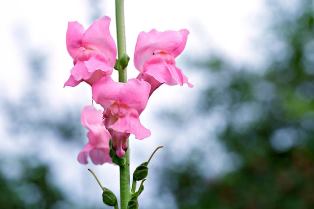
- Description: Snapdragon flowers are characterized by their tall spikes and vibrant, dragon-shaped blossoms that can open and close when gently squeezed. They come in a variety of colors, including pink, red, yellow, and white.
- Scientific Name: Antirrhinum majus
- Growing Conditions: Prefer full sun and well-drained soil.
- Uses: Popular in gardens and floral arrangements for their bright colors and unique shape.
Sunflower
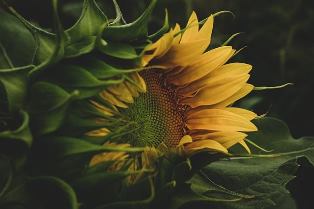
- Description: Known for their large, bright yellow petals and dark brown centers, sunflowers can grow several feet tall. They turn their heads to follow the sun throughout the day.
- Scientific Name: Helianthus annuus
- Growing Conditions: Thrive in full sun and can tolerate a variety of soils.
- Uses: Cultivated for their seeds, oil, and ornamental beauty.
Sweet Pea
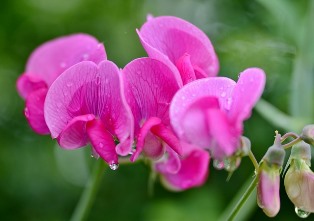
- Description: Sweet Peas are climbing plants that produce fragrant, colorful flowers in shades of pink, purple, red, and white. They are known for their delicate, butterfly-like blooms.
- Scientific Name: Lathyrus odoratus
- Growing Conditions: Prefer cool climates, full sun to partial shade, and rich, well-drained soil.
- Uses: Grown for their fragrance and beauty, often used in bouquets and gardens.
Scabiosa

- Description: Scabiosa, or pincushion flower, features rounded flower heads on slender stems, resembling pincushions. They come in shades of blue, pink, and white.
- Scientific Name: Scabiosa spp.
- Growing Conditions: Full sun to partial shade, well-drained soil.
- Uses: Attractive to butterflies, used in gardens and floral arrangements.
Salvia
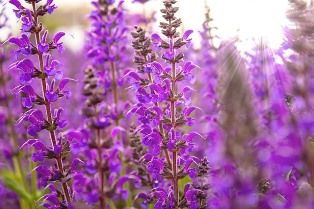
- Description: Salvias are known for their spikes of tubular flowers in a variety of colors, including blue, red, pink, and white. They have aromatic leaves.
- Scientific Name: Salvia spp.
- Growing Conditions: Full sun, well-drained soil.
- Uses: Ornamental gardening, herbal medicine, and attracting pollinators.
Snowdrop
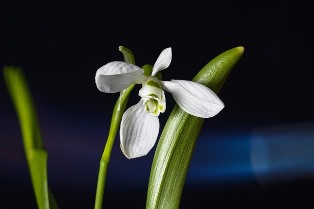
- Description: Snowdrops are small, delicate white flowers that bloom in early spring. They have nodding, bell-shaped blooms and are among the first flowers to appear after winter.
- Scientific Name: Galanthus nivalis
- Growing Conditions: Partial shade, moist, well-drained soil.
- Uses: Symbol of hope and renewal, often planted in woodland gardens.
Stephanotis
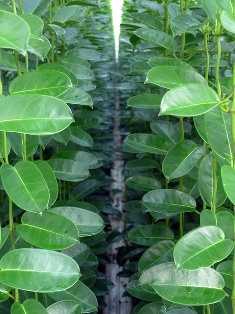
- Description: Stephanotis, or Madagascar Jasmine, produces waxy, fragrant white flowers. They are often used in wedding bouquets for their elegance and scent.
- Scientific Name: Stephanotis floribunda
- Growing Conditions: Bright, indirect light, well-drained soil.
- Uses: Popular in bridal arrangements and as a houseplant.
Statice
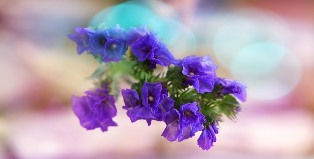
- Description: Statice flowers are known for their papery, long-lasting blooms in shades of purple, blue, white, and yellow. They are often used as dried flowers.
- Scientific Name: Limonium spp.
- Growing Conditions: Full sun, well-drained soil.
- Uses: Fresh and dried floral arrangements, everlasting bouquets.
Star of Bethlehem
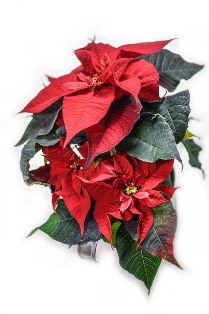
- Description: This flower features star-shaped white blooms with green stripes on the underside of the petals. It blooms in late spring to early summer.
- Scientific Name: Ornithogalum umbellatum
- Growing Conditions: Full sun to partial shade, well-drained soil.
- Uses: Ornamental gardens, known for their star-like appearance.
Sweet William
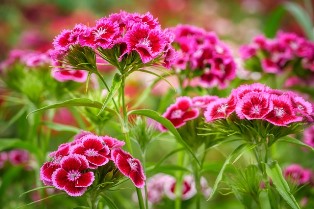
- Description: Sweet William is a biennial or short-lived perennial with clusters of small, fragrant flowers in a range of colors, including red, pink, white, and purple.
- Scientific Name: Dianthus barbatus
- Growing Conditions: Full sun to partial shade, well-drained soil.
- Uses: Cottage gardens, borders, and cut flowers.
Safflower
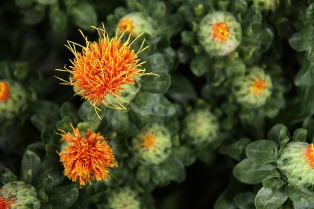
- Description: Safflower is a thistle-like plant with bright yellow, orange, or red flower heads. It is cultivated for its oil-rich seeds.
- Scientific Name: Carthamus tinctorius
- Growing Conditions: Full sun, dry, well-drained soil.
- Uses: Oil production, birdseed, and natural dye.
Sand Verbena
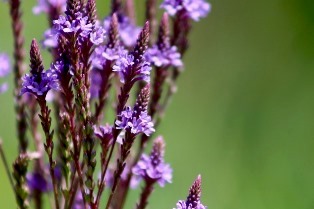
- Description: Sand Verbena produces clusters of fragrant, tubular flowers in colors like pink, purple, and white. It is a low-growing plant often found in sandy soils.
- Scientific Name: Abronia spp.
- Growing Conditions: Full sun, sandy, well-drained soil.
- Uses: Groundcover, coastal and desert gardens.
Scarlet Sage

- Description: Scarlet Sage, or red salvia, features bright red tubular flowers that attract hummingbirds and butterflies. It blooms from summer to fall.
- Scientific Name: Salvia splendens
- Growing Conditions: Full sun, well-drained soil.
- Uses: Ornamental gardening, attracting pollinators.
Sea Holly
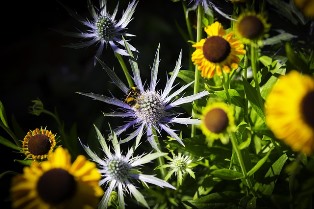
- Description: Sea Holly is known for its spiky, thistle-like flowers with a metallic blue hue. The plant has a striking architectural form.
- Scientific Name: Eryngium spp.
- Growing Conditions: Full sun, well-drained soil.
- Uses: Borders, rock gardens, and dried flower arrangements.
Senecio
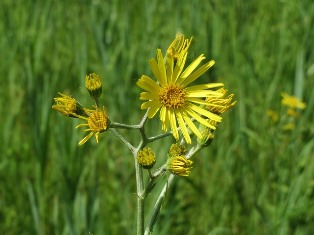
- Description: Senecio is a large genus with diverse species, including groundcovers, shrubs, and succulent plants. They often have daisy-like yellow flowers.
- Scientific Name: Senecio spp.
- Growing Conditions: Varies by species, generally prefers full sun and well-drained soil.
- Uses: Ornamental gardening, ground cover.
Shasta Daisy

- Description: Shasta Daisy features classic white petals with a yellow center. It is a hardy perennial that blooms in summer.
- Scientific Name: Leucanthemum × superbum
- Growing Conditions: Full sun, well-drained soil.
- Uses: Garden borders, cut flowers.
Siberian Iris

- Description: Siberian Iris has elegant, sword-like foliage and blooms in shades of blue, purple, white, and yellow. It is known for its hardiness and graceful flowers.
- Scientific Name: Iris sibirica
- Growing Conditions: Full sun to partial shade, moist, well-drained soil.
- Uses: Ornamental gardens, water features.
Silene

- Description: Silene, also known as catchfly, produces clusters of small, star-shaped flowers in colors like pink, red, and white. Some species are known for their sticky stems.
- Scientific Name: Silene spp.
- Growing Conditions: Full sun to partial shade, well-drained soil.
- Uses: Rock gardens, borders.
Silk Tree
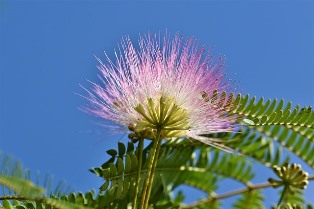
- Description: Silk Tree, or mimosa, is a small deciduous tree with feathery leaves and fluffy pink flower clusters. It has a tropical appearance.
- Scientific Name: Albizia julibrissin
- Growing Conditions: Full sun, well-drained soil.
- Uses: Ornamental tree, shade tree.
Silver Lace Vine

- Description: Silver Lace Vine is a fast-growing vine with small, fragrant white flowers that bloom in late summer. It is known for its vigorous growth and attractive foliage.
- Scientific Name: Polygonum aubertii
- Growing Conditions: Full sun to partial shade, well-drained soil.
- Uses: Arbors, trellises, and fences.
Skunk Cabbage
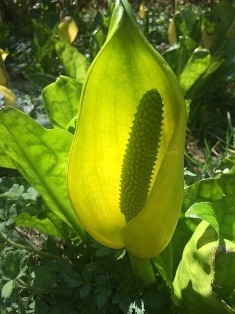
- Description: Skunk Cabbage is a unique plant with large, foul-smelling leaves and a hood-like flower structure. It emerges early in spring.
- Scientific Name: Symplocarpus foetidus
- Growing Conditions: Wet, swampy areas.
- Uses: Wetland gardens, natural habitats.
Slipper Orchid

- Description: Slipper Orchids, or Paphiopedilums, are known for their slipper-shaped pouches and intricate patterns. They come in various colors and patterns.
- Scientific Name: Paphiopedilum spp.
- Growing Conditions: Indirect light, well-drained, moisture-retentive soil.
- Uses: Houseplants, orchid collections.
Smallwort
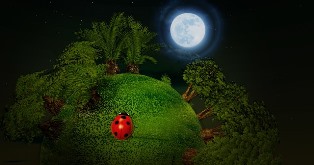
- Description: Smallwort, or stitchwort, produces delicate white flowers with five deeply notched petals. It is a low-growing plant often found in meadows.
- Scientific Name: Stellaria spp.
- Growing Conditions: Partial shade, moist, well-drained soil.
- Uses: Groundcover, wildflower gardens.
Soapwort
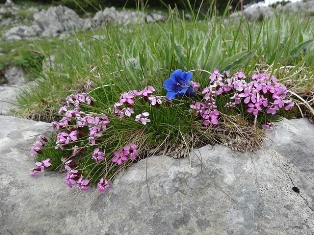
- Description: Soapwort produces clusters of pink or white flowers and has leaves that can create a lather when mixed with water. It is often used in natural soap-making.
- Scientific Name: Saponaria officinalis
- Growing Conditions: Full sun to partial shade, well-drained soil.
- Uses: Soap-making, ornamental gardens.
Solomon’s Seal

- Description: Solomon’s Seal has arching stems with small, bell-shaped white flowers that hang below the leaves. It is a shade-loving perennial.
- Scientific Name: Polygonatum spp.
- Growing Conditions: Partial to full shade, moist, well-drained soil.
- Uses: Shade gardens, woodland gardens.
Speedwell

- Description: Speedwell, or Veronica, features spikes of small, tubular flowers in blue, pink, white, or purple. It is a hardy perennial with a long blooming period.
- Scientific Name: Veronica spp.
- Growing Conditions: Full sun to partial shade, well-drained soil.
- Uses: Borders, rock gardens, groundcover.
Spider Lily
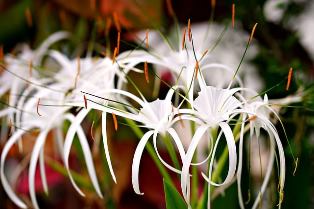
- Description: Spider Lilies have striking, spidery white or red flowers with long, curving petals. They bloom in late summer and fall.
- Scientific Name: Lycoris spp.
- Growing Conditions: Full sun to partial shade, well-drained soil.
- Uses: Ornamental gardens, bulb gardens.
Spiked Speedwell
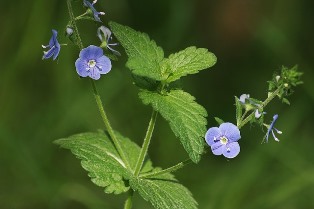
- Description: Spiked Speedwell, or Veronica spicata, produces tall spikes of small, tubular flowers in blue, pink, white, or purple. It is a hardy perennial with a long blooming period.
- Scientific Name: Veronica spicata
- Growing Conditions: Full sun to partial shade, well-drained soil.
- Uses: Borders, rock gardens, groundcover.
Spiraea
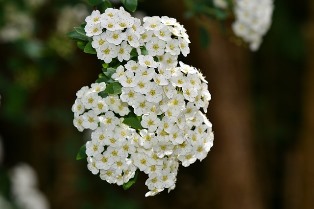
- Description: Spiraea, or bridal wreath, is a deciduous shrub with clusters of small white or pink flowers. It blooms in spring and summer.
- Scientific Name: Spiraea spp.
- Growing Conditions: Full sun to partial shade, well-drained soil.
- Uses: Hedges, borders, ornamental gardens.
Spotted Deadnettle
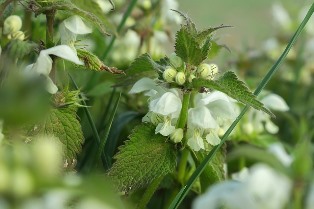
- Description: Spotted Deadnettle has heart-shaped leaves with silver spots and produces clusters of pink or white flowers. It is a shade-tolerant groundcover.
- Scientific Name: Lamium maculatum
- Growing Conditions: Partial to full shade, moist, well-drained soil.
- Uses: Groundcover, shade gardens.
Spring Beauty
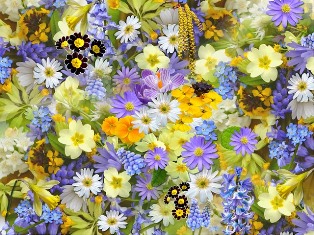
- Description: Spring Beauty is a small, early spring bloomer with pink or white flowers with dark pink veins. It is often found in woodlands.
- Scientific Name: Claytonia virginica
- Growing Conditions: Partial shade, moist, well-drained soil.
- Uses: Wildflower gardens, woodland gardens.
St. John’s Wort
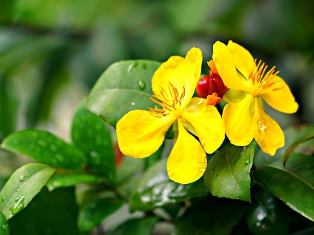
- Description: St. John’s Wort is a medicinal herb with bright yellow flowers and perforated leaves. It is known for its antidepressant properties.
- Scientific Name: Hypericum perforatum
- Growing Conditions: Full sun, well-drained soil.
- Uses: Herbal medicine, ornamental gardens.
Star Jasmine

- Description: Star Jasmine is a climbing plant with fragrant, star-shaped white flowers. It is often used as a groundcover or on trellises.
- Scientific Name: Trachelospermum jasminoides
- Growing Conditions: Full sun to partial shade, well-drained soil.
- Uses: Ornamental gardens, fragrant gardens.
Star Magnolia
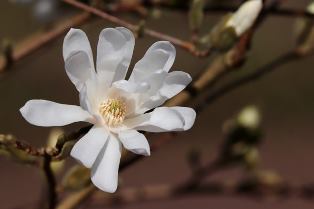
- Description: Star Magnolia is a small tree with large, fragrant, star-shaped white or pink flowers. It blooms in early spring.
- Scientific Name: Magnolia stellata
- Growing Conditions: Full sun to partial shade, well-drained soil.
- Uses: Ornamental tree, early spring gardens.
Stokesia

- Description: Stokesia, or Stokes’ Aster, produces large, blue, lavender, or white flowers with fringed petals. It is a hardy perennial.
- Scientific Name: Stokesia laevis
- Growing Conditions: Full sun, well-drained soil.
- Uses: Borders, cut flowers, ornamental gardens.
Stonecrop

- Description: Stonecrop, or Sedum, is a succulent plant with fleshy leaves and star-shaped flowers in various colors. It is drought-tolerant and low-maintenance.
- Scientific Name: Sedum spp.
- Growing Conditions: Full sun, well-drained soil.
- Uses: Rock gardens, groundcover, green roofs.
Strawberry
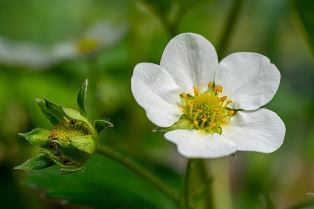
- Description: Strawberry plants produce white flowers and red, juicy fruits. They are low-growing and spread by runners.
- Scientific Name: Fragaria × ananassa
- Growing Conditions: Full sun, well-drained soil.
- Uses: Edible gardening, groundcover.
Strawberry Geranium

- Description: Strawberry Geranium, or Strawberry Begonia, has round, fuzzy leaves and small white flowers. It is a low-growing plant often used as a groundcover.
- Scientific Name: Saxifraga stolonifera
- Growing Conditions: Partial shade, moist, well-drained soil.
- Uses: Groundcover, container gardens.
Streptocarpus
- Description: Streptocarpus, or Cape Primrose, produces clusters of tubular flowers in various colors, including blue, pink, and white. It is a popular houseplant.
- Scientific Name: Streptocarpus spp.
- Growing Conditions: Bright, indirect light, well-drained soil.
- Uses: Houseplants, indoor gardens.
Summer Hyacinth

- Description: Summer Hyacinth produces tall spikes of fragrant white flowers in late summer. It is a bulbous plant with strap-like leaves.
- Scientific Name: Galtonia candicans
- Growing Conditions: Full sun to partial shade, well-drained soil.
- Uses: Borders, cut flowers, bulb gardens.
Summer Phlox

- Description: Summer Phlox, or garden phlox, features large clusters of fragrant flowers in shades of pink, purple, red, and white. It blooms in midsummer.
- Scientific Name: Phlox paniculata
- Growing Conditions: Full sun to partial shade, well-drained soil.
- Uses: Borders, cut flowers, cottage gardens.
Sundew

- Description: Sundew is a carnivorous plant with sticky, glandular leaves that trap insects. It produces small, delicate flowers in white or pink.
- Scientific Name: Drosera spp.
- Growing Conditions: Full sun to partial shade, boggy, acidic soil.
- Uses: Carnivorous plant collections, bog gardens.
Sunrose
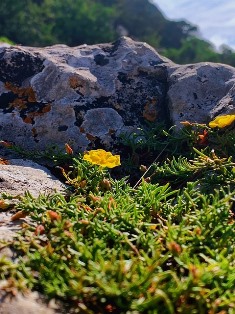
- Description: Sunrose, or Helianthemum, is a low-growing shrub with brightly colored flowers in shades of red, orange, yellow, and pink. It is drought-tolerant.
- Scientific Name: Helianthemum spp.
- Growing Conditions: Full sun, well-drained soil.
- Uses: Rock gardens, groundcover.
Swamp Milkweed
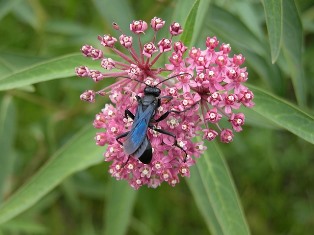
- Description: Swamp Milkweed produces clusters of pink or white flowers and is an important host plant for monarch butterflies. It grows well in wet areas.
- Scientific Name: Asclepias incarnata
- Growing Conditions: Full sun, moist to wet soil.
- Uses: Butterfly gardens, wetland gardens.
Swamp Rose
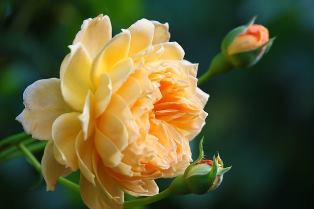
- Description: Swamp Rose is a native shrub with fragrant pink flowers and thorny stems. It grows well in wet, swampy areas.
- Scientific Name: Rosa palustris
- Growing Conditions: Full sun to partial shade, moist to wet soil.
- Uses: Wetland gardens, natural habitats.
Sweet Alyssum
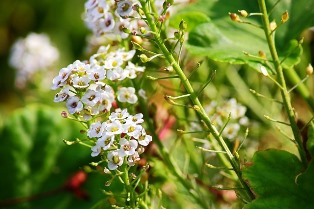
- Description: Sweet Alyssum is a low-growing plant with clusters of small, fragrant white, pink, or purple flowers. It is often used as a groundcover.
- Scientific Name: Lobularia maritima
- Growing Conditions: Full sun to partial shade, well-drained soil.
- Uses: Groundcover, borders, container gardens.
Sweet Bay Magnolia
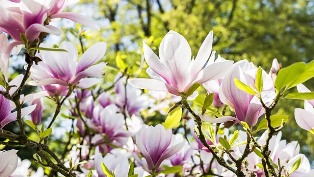
- Description: Sweet Bay Magnolia is a small tree with large, fragrant white flowers and glossy green leaves. It blooms in late spring to early summer.
- Scientific Name: Magnolia virginiana
- Growing Conditions: Full sun to partial shade, moist, well-drained soil.
- Uses: Ornamental tree, fragrant gardens.
Sweet Cherry

- Description: Sweet Cherry trees produce clusters of white flowers in spring and red, sweet fruits in early summer. They are valued for their fruit and ornamental beauty.
- Scientific Name: Prunus avium
- Growing Conditions: Full sun, well-drained soil.
- Uses: Fruit production, ornamental gardens.
Sweet Cicely
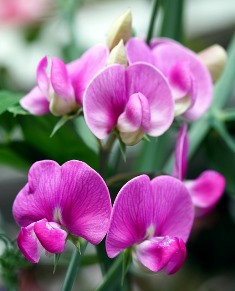
- Description: Sweet Cicely has feathery leaves and clusters of small white flowers. It is known for its anise-scented foliage and seeds.
- Scientific Name: Myrrhis odorata
- Growing Conditions: Partial shade, moist, well-drained soil.
- Uses: Herb gardens, ornamental gardens, culinary uses.
Sweet Sultan
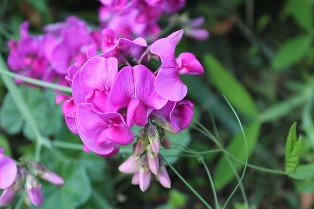
- Description: Sweet Sultan, or Amberboa, has large, fragrant, thistle-like flowers in shades of pink, purple, and white. It blooms in summer.
- Scientific Name: Amberboa moschata
- Growing Conditions: Full sun, well-drained soil.
- Uses: Borders, cut flowers, fragrant gardens.
Sweet Woodruff
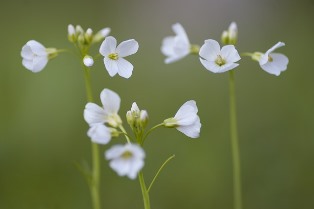
- Description: Sweet Woodruff is a low-growing groundcover with whorled leaves and small, white, star-shaped flowers. It has a sweet, hay-like fragrance.
- Scientific Name: Galium odoratum
- Growing Conditions: Partial to full shade, moist, well-drained soil.
- Uses: Groundcover, shade gardens, fragrant gardens.
Swertia
- Description: Swertia is a genus of flowering plants with star-shaped blue or purple flowers. They are often found in alpine and subalpine regions.
- Scientific Name: Swertia spp.
- Growing Conditions: Full sun to partial shade, well-drained soil.
- Uses: Rock gardens, alpine gardens.
Sycamore

- Description: Sycamore trees have broad, maple-like leaves and distinctive mottled bark. They produce clusters of small, greenish flowers.
- Scientific Name: Platanus spp.
- Growing Conditions: Full sun, well-drained soil.
- Uses: Shade tree, ornamental tree.
Symphyotrichum
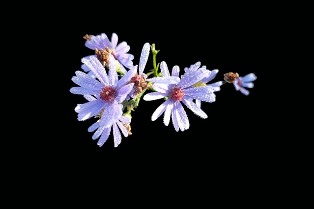
- Description: Symphyotrichum, or New England Aster, features clusters of daisy-like flowers in shades of purple, pink, and white. It blooms in late summer to fall.
- Scientific Name: Symphyotrichum novae-angliae
- Growing Conditions: Full sun to partial shade, well-drained soil.
- Uses: Borders, wildflower gardens, attracting pollinators.
Syringa
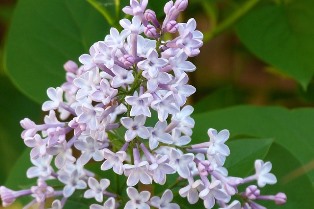
- Description: Syringa, or lilac, is a deciduous shrub with clusters of fragrant flowers in shades of purple, pink, white, and blue. It blooms in late spring.
- Scientific Name: Syringa spp.
- Growing Conditions: Full sun, well-drained soil.
- Uses: Ornamental gardens, fragrant gardens.
Schizanthus
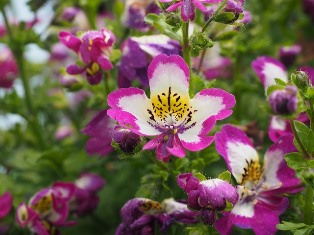
- Description: Schizanthus, or poor man’s orchid, produces clusters of orchid-like flowers in various colors. It is known for its intricate, delicate blooms.
- Scientific Name: Schizanthus spp.
- Growing Conditions: Full sun to partial shade, well-drained soil.
- Uses: Ornamental gardens, container gardens.
Scilla
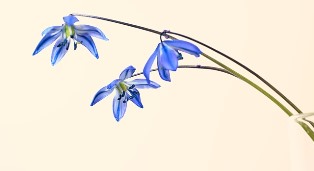
- Description: Scilla, or squill, features spikes of small, star-shaped blue or white flowers. It blooms in early spring and is often found in woodland areas.
- Scientific Name: Scilla spp.
- Growing Conditions: Full sun to partial shade, well-drained soil.
- Uses: Bulb gardens, woodland gardens.
Scorzonera
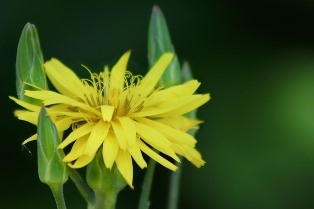
- Description: Scorzonera, or black salsify, produces bright yellow daisy-like flowers and is known for its edible roots. It is often grown as a vegetable.
- Scientific Name: Scorzonera hispanica
- Growing Conditions: Full sun, well-drained soil.
- Uses: Vegetable gardens, edible landscaping.
Scurvy Grass

- Description: Scurvy Grass has small, white, four-petaled flowers and is rich in vitamin C. It was historically used to prevent scurvy.
- Scientific Name: Cochlearia officinalis
- Growing Conditions: Full sun to partial shade, moist, well-drained soil.
- Uses: Herbal medicine, wildflower gardens.
Sedum
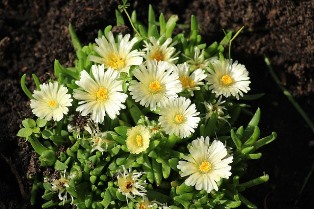
- Description: Sedum, or stonecrop, is a succulent plant with fleshy leaves and clusters of small, star-shaped flowers. It is drought-tolerant and low-maintenance.
- Scientific Name: Sedum spp.
- Growing Conditions: Full sun, well-drained soil.
- Uses: Rock gardens, groundcover, green roofs.
Seaside Daisy
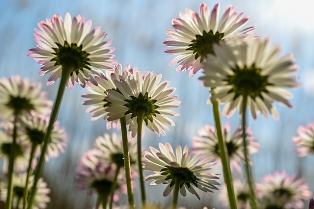
- Description: Seaside Daisy, or Erigeron, produces small, daisy-like flowers in shades of pink, purple, and white. It is a hardy, low-growing plant.
- Scientific Name: Erigeron glaucus
- Growing Conditions: Full sun, well-drained soil.
- Uses: Coastal gardens, rock gardens, groundcover.
Sequoia

- Description: Sequoia, or redwood, is a giant tree known for its massive size and longevity. It produces small, inconspicuous flowers and cones.
- Scientific Name: Sequoia sempervirens
- Growing Conditions: Full sun to partial shade, well-drained soil.
- Uses: Shade tree, timber production, ornamental tree.
Serissa

- Description: Serissa, or snowrose, is a small shrub with tiny white or pink flowers and glossy green leaves. It is often used as a bonsai plant.
- Scientific Name: Serissa foetida
- Growing Conditions: Full sun to partial shade, well-drained soil.
- Uses: Bonsai, ornamental gardens.
Serviceberry
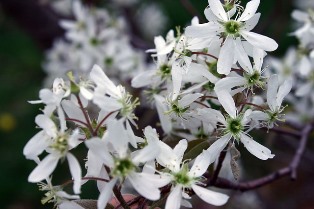
- Description: Serviceberry is a small tree or shrub with clusters of white flowers in spring, followed by edible berries. It has attractive fall foliage.
- Scientific Name: Amelanchier spp.
- Growing Conditions: Full sun to partial shade, well-drained soil.
- Uses: Edible landscaping, ornamental tree.
Shell Ginger

- Description: Shell Ginger is a tropical plant with large, variegated leaves and clusters of shell-like white and pink flowers. It is known for its striking foliage.
- Scientific Name: Alpinia zerumbet
- Growing Conditions: Full sun to partial shade, moist, well-drained soil.
- Uses: Tropical gardens, container gardens.
Shepherd’s Purse
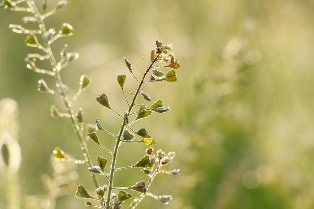
- Description: Shepherd’s Purse is a common weed with small, white, four-petaled flowers and heart-shaped seed pods. It is known for its medicinal properties.
- Scientific Name: Capsella bursa-pastoris
- Growing Conditions: Full sun to partial shade, well-drained soil.
- Uses: Herbal medicine, wildflower gardens.
Shoo-Fly Plant
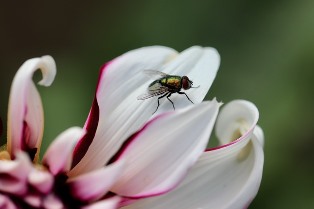
- Description: Shoo-Fly Plant, or Apple of Peru, has bell-shaped blue or purple flowers and is known for repelling insects. It is an annual plant.
- Scientific Name: Nicandra physalodes
- Growing Conditions: Full sun, well-drained soil.
- Uses: Ornamental gardens, insect repellent.
Shorea
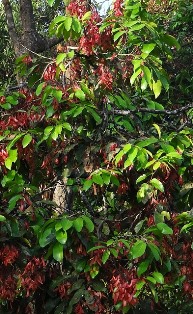
- Description: Shorea is a genus of tropical trees known for their hardwood and large, fragrant flowers. They are often used in timber production.
- Scientific Name: Shorea spp.
- Growing Conditions: Full sun to partial shade, well-drained soil.
- Uses: Timber production, ornamental tree.
Shrubby Cinquefoil
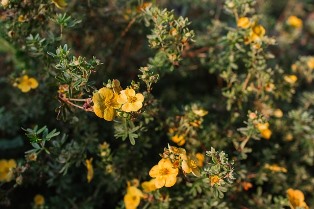
- Description: Shrubby Cinquefoil is a hardy shrub with small, buttercup-like yellow flowers. It blooms from spring to fall.
- Scientific Name: Potentilla fruticosa
- Growing Conditions: Full sun, well-drained soil.
- Uses: Borders, hedges, ornamental gardens.
Sidalcea

- Description: Sidalcea, or checkerbloom, features spikes of cup-shaped pink, purple, or white flowers. It is a hardy perennial.
- Scientific Name: Sidalcea spp.
- Growing Conditions: Full sun to partial shade, well-drained soil.
- Uses: Borders, wildflower gardens.
Silverbell
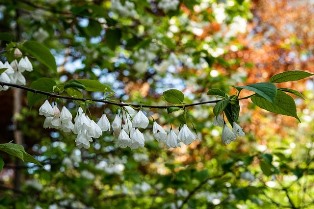
- Description: Silverbell is a small tree or shrub with bell-shaped white or pink flowers that bloom in spring. It has attractive fall foliage.
- Scientific Name: Halesia spp.
- Growing Conditions: Full sun to partial shade, well-drained soil.
- Uses: Ornamental tree, shade tree.
Silvery Lupine

- Description: Silvery Lupine is a wildflower with tall spikes of blue or purple flowers and silvery, hairy leaves. It is often found in meadows and prairies.
- Scientific Name: Lupinus argenteus
- Growing Conditions: Full sun, well-drained soil.
- Uses: Wildflower gardens, attracting pollinators.
Sisyrinchium

- Description: Sisyrinchium, or blue-eyed grass, produces small, star-shaped blue or purple flowers. It is a low-growing perennial often found in meadows and prairies.
- Scientific Name: Sisyrinchium spp.
- Growing Conditions: Full sun, well-drained soil.
- Uses: Wildflower gardens, groundcover.
Skimmia
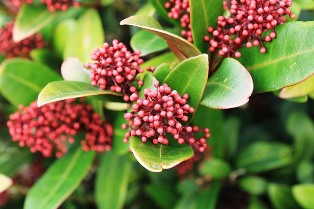
- Description: Skimmia is an evergreen shrub with fragrant white flowers and red berries. It is often used as a hedge or border plant.
- Scientific Name: Skimmia japonica
- Growing Conditions: Partial to full shade, moist, well-drained soil.
- Uses: Hedges, borders, shade gardens.
Skullcap
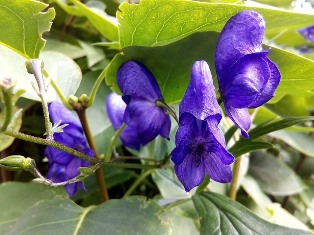
- Description: Skullcap is a herbaceous plant with small, tubular blue or purple flowers. It is known for its medicinal properties, particularly in treating anxiety.
- Scientific Name: Scutellaria spp.
- Growing Conditions: Full sun to partial shade, well-drained soil.
- Uses: Herbal medicine, ornamental gardens.
Sneezeweed

- Description: Sneezeweed is a tall perennial with daisy-like yellow or orange flowers. It blooms in late summer to fall.
- Scientific Name: Helenium spp.
- Growing Conditions: Full sun, well-drained soil.
- Uses: Borders, attracting pollinators, wildflower gardens.
Snowberry
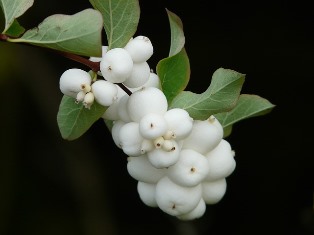
- Description: Snowberry is a deciduous shrub with small pink flowers and distinctive white berries. It is hardy and often used for erosion control.
- Scientific Name: Symphoricarpos albus
- Growing Conditions: Full sun to partial shade, well-drained soil.
- Uses: Ornamental gardens, erosion control, wildlife habitats.
Snow-in-Summer
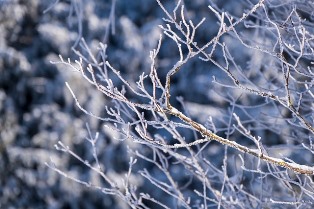
- Description: Snow-in-Summer is a low-growing perennial with silvery foliage and small white flowers that create a “snowy” effect when in bloom.
- Scientific Name: Cerastium tomentosum
- Growing Conditions: Full sun, well-drained soil.
- Uses: Groundcover, rock gardens, borders.
Snowy Mespilus
- Description: Snowy Mespilus, or Amelanchier lamarckii, is a small tree with white spring flowers, followed by edible berries and attractive fall foliage.
- Scientific Name: Amelanchier lamarckii
- Growing Conditions: Full sun to partial shade, well-drained soil.
- Uses: Ornamental tree, edible landscaping.
Soap Aloe
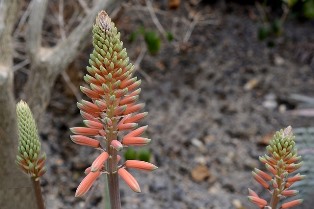
- Description: Soap Aloe is a succulent plant with fleshy, spiny leaves and tubular red or orange flowers. It is known for its medicinal properties.
- Scientific Name: Aloe maculata
- Growing Conditions: Full sun, well-drained soil.
- Uses: Medicinal gardens, rock gardens, containers.
Sorrel

- Description: Sorrel is a herbaceous plant with tangy, lemon-flavored leaves used in salads and cooking. It produces small, greenish flowers.
- Scientific Name: Rumex acetosa
- Growing Conditions: Full sun to partial shade, well-drained soil.
- Uses: Culinary uses, herb gardens, ornamental gardens.
Spanish Bayonet
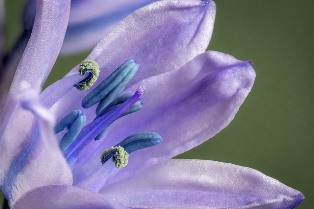
- Description: Spanish Bayonet is a type of yucca with sharp, sword-like leaves and tall spikes of white, bell-shaped flowers. It is drought-tolerant and hardy.
- Scientific Name: Yucca aloifolia
- Growing Conditions: Full sun, well-drained soil.
- Uses: Xeriscaping, ornamental gardens, security plantings.
Spanish Bluebell

- Description: Spanish Bluebell is a bulbous plant with bell-shaped blue, pink, or white flowers that bloom in spring. It is known for its hardiness and adaptability.
- Scientific Name: Hyacinthoides hispanica
- Growing Conditions: Full sun to partial shade, well-drained soil.
- Uses: Borders, woodland gardens, bulb gardens.
Sphaeralcea
- Description: Sphaeralcea, or globemallow, is a perennial with bright orange or red flowers and silvery-green foliage. It is drought-tolerant and hardy.
- Scientific Name: Sphaeralcea spp.
- Growing Conditions: Full sun, well-drained soil.
- Uses: Wildflower gardens, xeriscaping.
Spider Flower

- Description: Spider Flower, or Cleome, produces tall spikes of pink, white, or purple flowers with long, spidery stamens. It blooms from summer to fall.
- Scientific Name: Cleome hassleriana
- Growing Conditions: Full sun, well-drained soil.
- Uses: Borders, cut flowers, ornamental gardens.
Spider Plant
- Description: Spider Plant is a popular houseplant with arching leaves and small white flowers. It is known for its air-purifying qualities.
- Scientific Name: Chlorophytum comosum
- Growing Conditions: Bright, indirect light, well-drained soil.
- Uses: Houseplants, hanging baskets, indoor gardens.
Spikenard
- Description: Spikenard is a herbaceous plant with small, fragrant white or pink flowers. It is known for its aromatic roots used in perfumes and incense.
- Scientific Name: Aralia racemosa
- Growing Conditions: Partial shade, moist, well-drained soil.
- Uses: Herbal medicine, ornamental gardens, fragrance production.
Spring Snowflake
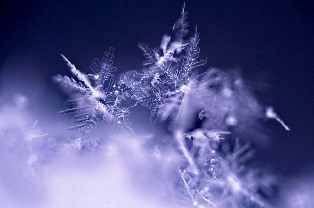
- Description: Spring Snowflake is a bulbous plant with bell-shaped white flowers that have green tips. It blooms in early spring.
- Scientific Name: Leucojum vernum
- Growing Conditions: Full sun to partial shade, well-drained soil.
- Uses: Bulb gardens, borders, woodland gardens.
Spurflower
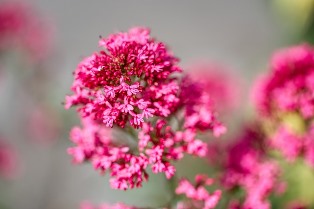
- Description: Spurflower, or Plectranthus, is a genus of plants with aromatic leaves and spikes of tubular flowers in various colors. It is often grown as a houseplant.
- Scientific Name: Plectranthus spp.
- Growing Conditions: Bright, indirect light, well-drained soil.
- Uses: Houseplants, container gardens, ornamental gardens.
Star Cluster

- Description: Star Cluster, or Pentas, produces clusters of star-shaped flowers in shades of pink, red, white, and purple. It attracts butterflies and blooms year-round in warm climates.
- Scientific Name: Pentas lanceolata
- Growing Conditions: Full sun to partial shade, well-drained soil.
- Uses: Butterfly gardens, borders, container gardens.
Starflower
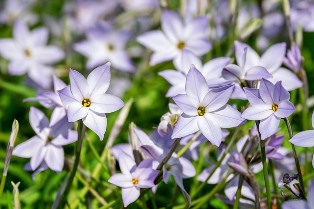
- Description: Starflower, or Trientalis, is a small woodland plant with delicate, star-shaped white flowers. It blooms in late spring to early summer.
- Scientific Name: Trientalis borealis
- Growing Conditions: Partial shade, moist, well-drained soil.
- Uses: Woodland gardens, wildflower gardens.
Strawflower
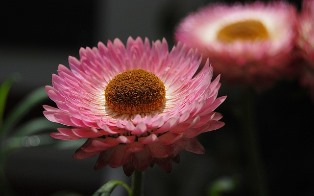
- Description: Strawflower is an annual plant with papery, daisy-like flowers in a variety of colors. It is often used in dried flower arrangements.
- Scientific Name: Xerochrysum bracteatum
- Growing Conditions: Full sun, well-drained soil.
- Uses: Dried flowers, borders, cut flowers.
Sundrop
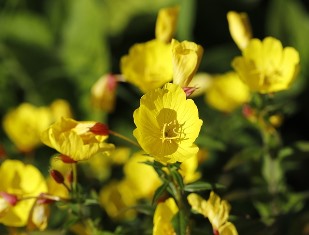
- Description: Sundrop, or Evening Primrose, produces bright yellow flowers that open in the evening and close by midday. It is a hardy perennial.
- Scientific Name: Oenothera fruticosa
- Growing Conditions: Full sun, well-drained soil.
- Uses: Wildflower gardens, borders, attracting pollinators.
Sunspurge
- Description: Sunspurge, or Euphorbia helioscopia, is a small, annual plant with yellow-green flowers. It is known for its unique growth habit and milky sap.
- Scientific Name: Euphorbia helioscopia
- Growing Conditions: Full sun, well-drained soil.
- Uses: Ornamental gardens, wildflower gardens.

